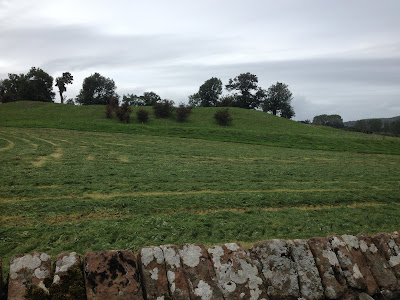The Cuckoo Stone is a fairly modest
standing stone around a mile from Stonehenge. The sarsen is one of many
which once littered the landscape, left here long ago by glacial action, and
the stone was simply raised in its original, natural location. It has long
since fallen again.
A pit near the stone contained cattle
bone, flint, pottery and an antler pick, perhaps the tools used to raise the
stone and the subsequent feast to consecrate it. The pick dates to 2900BC, the
earliest phase of Stonehenge which at this point comprised a circle of
bluestones but none of the huge sarsens.
Bronze Age burial urn from the
Stonehenge area.
The Cuckoo Stone remained a revered
site for the next three thousand years. Several Bronze Age cremation urns were interred
around the stone, with dates ranging from 2000BC to 1260BC. Much later still, a
Roman-era village with large farms and a wide spread of fields grew up around
the stone, and burials from this period were inserted into a Bronze Age barrow
a short distance away near Woodhenge. Almost certainly this village was
the home of people whose ancestry stretched back to the Neolithic and Bronze
Age inhabitants of the area, despite their adaptation of Roman ways in the
early centuries CE, and they were successors to the ancient traditions of the
still-sacred Stonehenge landscape.
The Cuckoo Stone looking towards
Woodhenge
Why was the Cuckoo Stone so
important? It lies on gently sloping grassland on the eastern edge of Salisbury
Plain, with wide views in all directions but the west, where Stonehenge itself
is hidden by the slope. The stone is on the same alignment as the Stonehenge Cursus, an enigmatic ditched enclosure 3km long and 100m wide, which seems
to commemorate an ancient routeway. This route, and perhaps the cursus if it
had been continued, would have incorporated the Cuckoo Stone, at the time
recumbent but eventually raised, and continued to Woodhenge a few
hundred metres to the east.
We will probably never know the
reason for the importance of this alignment of natural features, but they
remained respected in people’s memories as the Neolithic was succeeded by the
Bronze Age, as Celts and then Romans swept across Britain and the country’s way
of life changed beyond recognition, again and again. Eventually the Cuckoo
Stone succumbed and became a mere rock in a field, but thanks to recent
archaeology, its importance has been rediscovered.



















































